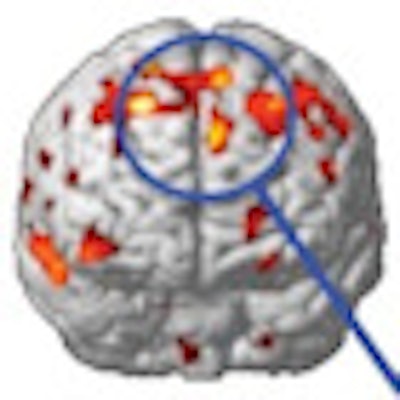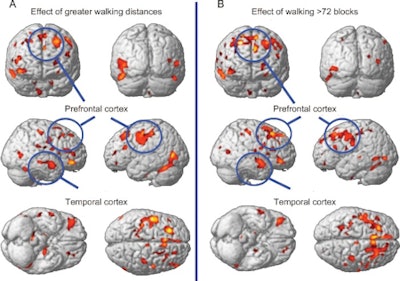
U.S. researchers used MRI to show that walking at least 6 miles per week may preserve brain size and help prevent Alzheimer's disease and mild cognitive impairment as adults age, according to a study published October 13 in the online issue of Neurology, the medical journal of the American Academy of Neurology.
Researchers at the University of Pittsburgh used 1.5-tesla MRI to determine that over the course of nine years, older adults who were more physically active had greater gray matter in certain brain regions and had a reduced risk of cognitive impairment (Neurology, Vol. 75:15, pp. 1415-1422).
"There are so many different factors throughout our lives and lifestyle habits that influence our brain function, including genetic factors," said lead author Kirk Erickson, PhD, an assistant professor in the university's department of psychology. "The fact that we can take this one single snapshot in time of how physically active you are and find that that is related to the amount of brain tissue you have nine years later is really quite amazing."
The 299 participants in the research came from the Cardiovascular Health Study Cognition Study (CHS-CS), which began approximately 20 years ago to explore coronary heart disease and stroke in people age 65 and older. The goal of the CHS-CS was to collect information on the different factors that contribute to cardiovascular health, including physical activity.
Brain functions
"As that sample population began to age, they had more issues at stake other than just cardiovascular disease, including Alzheimer's disease and dementia," Erickson said. "That's when they started also to collect information about how their brains were functioning as well."
Early in the CHS-CS, researchers began to measure the amount of physical activity among their subjects and performed low-resolution 1.5-tesla MR images.
Nine years later, high-resolution 1.5-tesla MR images (GE Signa, GE Healthcare, Chalfont St. Giles, U.K.) were acquired of those same subjects at the University of Pittsburgh Medical Center MR Research Center. That's when Erickson and his colleagues analyzed the scans to look for signs of cognitive impairment and dementia among the 299 subjects. Follow-up MRI scans were performed again four years later.
"From this fairly large sample of people, we were able to go back and examine how much physical activity they had earlier in life, and then measure and examine how their brain was functioning much later in life," Erickson said.
Physical activity
The 299 participants had a mean age of 78 and included 182 women. All subjects were determined to be cognitively normal at the time of the high-resolution MRI scans. Physical activity consisted of walking a number of blocks, ranging from 0 to 300, over a one-week period. The mean number of blocks walked was 56.3.
The study found that people who walked at least 72 blocks per week, or approximately 6 to 9 miles, had greater gray-matter volume than people who walked less, when measured at the nine-year time point. In addition, walking more than 72 blocks did not appear to increase gray-matter volume in the brain.
Four years later, it was found that 116 participants (40%) had developed cognitive impairment or dementia, and the subjects who walked the most reduced their risk of developing memory problems by approximately 50%.
Clinically speaking, the MRI scans revealed greater gray-matter volume in the inferior frontal gyrus, hippocampal formation, and supplementary motor area, which are associated with a reduced risk of developing cognitive impairment.
 |
| The effect of physical activity is shown in brain regions (A) (orange) at baseline and greater gray-matter volume. The effect of walking more than 72 blocks (B) (orange) shows greater volume of gray matter in the brain in the highest quartile, compared to the bottom three quartiles. Images courtesy of University of Pittsburgh and Neurology. |
"In short, walking greater distances was associated with greater [gray-matter] volume in specific regions, and greater [gray-matter] volume was associated with a lower risk for experiencing cognitive impairment in later years," Erickson and colleagues wrote.
Greater brain tissue
"Even over a nine-year period -- and this still astonishes me -- we could predict how much brain tissue you will have by looking at how much physical activity you did nine years ago," Erickson told AuntMinnie.com. "We were able to follow them for another four years after that and were able to determine that greater brain tissue associated with more physical activity directly leads to the reduced risk of developing Alzheimer's."
Erickson and his colleagues plan to continue their research and explore cognitive impairment on the molecular level with the help of PET.
"We are learning more and more about the molecular processes with Alzheimer's disease and some of the putative causes of Alzheimer's, especially amyloid beta and whether or not physical activity reduces the amount of amyloid beta in these people's brains," Erickson said. "Maybe these people have the same amount of amyloid beta, but they are able to, in some way, withstand the presence of it. They are still able to function, even though there is amyloid beta."
He added that more clinical trials must be done in this area, with researchers going beyond the effective drug treatments for Alzheimer's patients to investigate lifestyle factors.
"It is too easy for us to fall into this idea that if there is no pharmaceutical treatment or cure to relieve you of these symptoms or to prevent the symptoms from occurring or developing, then we don't look at anything else," Erickson said. "Physical activity is a low-cost behavior that virtually everyone has access to and it has relatively few side effects."
The study was supported by the National Institute on Aging.
By Wayne Forrest
AuntMinnie.com staff writer
October 14, 2010
Related Reading
MRI helps identify mild cognitive impairment, October 5, 2010
MRI beats FDG-PET for early Alzheimer's detection, August 27, 2010
MRI finds genetic link in Alzheimer's disease, June 14, 2010
MRI hippocampal measurement doesn't predict cognitive decline, April 26, 2010
MR scans may detect signs of early dementia in elderly, April 14, 2010
Copyright © 2010 AuntMinnie.com




















